Return to Sitemap
Rev. 2006-07-28, -08-15, -12-04, 2009-05-25
In 1998, I made a determined effort to visit the existing
studios that I could reach in a short period of time from Dallas while I was
working five non-consecutive days each week with two weeks vacation each year.
Not going as far as Houston, I looped through several cities in mid-Texas.
Included here is a visit to the museum at Texas A&M
Some of the sites shown on this page no longer exist and the text has been
edited to reflect looking back instead of as a current visit.
Von Koef North, South 1, South 2, South 3
| Scarborough Faire |
| Wimberley |
| Studio & Gallery |
| Zero Gravity |
| Texas A&M |
| Grapevine |
| Art Allison |
| Fire Island |
Wimberley, Texas, is the site of more than its share of artists. Located southwest of Austin at the eastern edge of the Hill Country, the area has attracted artists for years. I went back for a visit in late April 1998. One place producing primarily large scale slumped glass sculpture pieces, owned by David Foglia, is missing because it was closed when I visited.
| Wimberley Glass Works is located just south of town and does public demonstrations over the weekend. Owner is Tim de Jong. The two building complex includes a gallery area with glass hanging outside and the blowing studio. Glass shown is almost entirely production goblets, glasses and pitchers. They are now (2006) a very serious large glass production studio - check it out http://www.wgw.com/ and have moved 5 miles down the road from this site, see the web site 2006-10-25 |
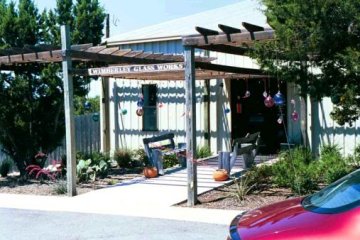 |
| This is the second building, just to the left of the picture above, containing the hot and cold shops. On a more recent visit, an extension to the back was added for ventilation and air supply blowers. |
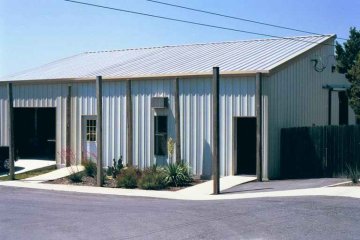 |
|
This is the interior of the building just above, showing the hot wall. On a more recent visit, holes had been cut in the wall so the noisy blowers could be moved beyond the wall and ventilation would be more positive. The wall at the bottom of the picture separates the viewing area from the hot floor and the pipe in front of that is the protective railing in front of several rows of seats. The cold shop is over to the left.
|
 |
Last Updated : July 2, 1998 - 2006-07-29
| Marti Johnson operates one of the newer (in 1998) studios in Texas near
the town of Spicewood northwest of Austin. Hers is primarily a
production studio. I arrived later than I planned and caught her
just as she was starting a piece before going off on errands so I
took a number of pictures, asked a few questions, and we went our
ways. [Updated 98-7-13 That Glass Girl, 25418 River Road, Spicewood, TX 78669. www.thatglassgirl.com site gone studio closed, 2009-05 ] |
|
| This shot shows Marti starting a piece, but was mostly taken to show the hugely insulated furnace, about a foot of it all around, and the glory hole with its unusual handle arrangement, note the pipe out just in front of her face, which pivots rod that pushes on two other rods that open and close the doors. |
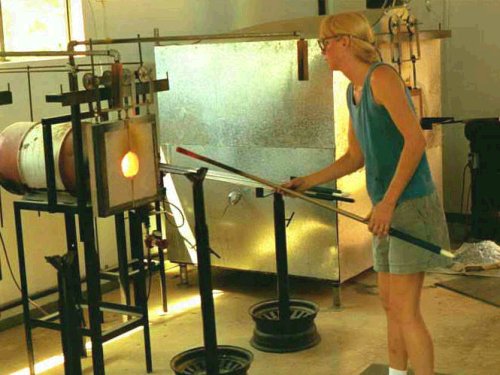 |
| The rest of Marti's hot face, with another glory hole with the same door arrangement and a fuming/dusting box. The marver at the left has a (glass) bowl with water in it for cracking the piece and the annealer is further to the left. |
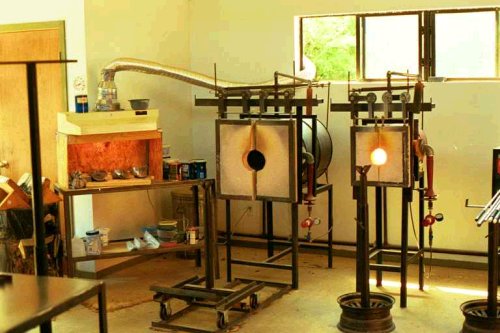 |
| I think the most important point about the door rig is that the handle is right out front for the solo worker to use, running off the right edge of this picture. The cross bar just below the pipe elbow in the middle of the picture has pulleys/wheels at each end which force the outside rods together or apart. The outside rods are pivoted at the doors and slide through eyes at the back of the unit. |
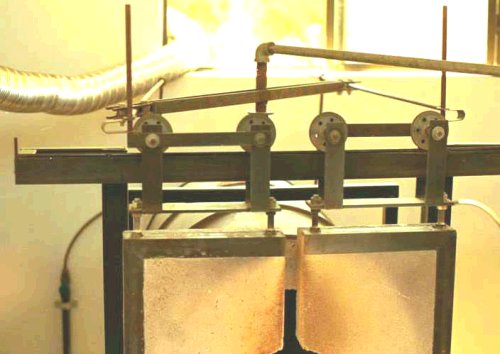 |
| It may take a moment of study to notice that Marti is working left handed in this shot, but I would have to include another shot that I don't have to reveal that she works glass both ways. A quick judgment might be that she seems to have her metal tools at this end of the bench and her wooden ones at the other end. I am ambidextrous also, but I don't recall having tried working glass yet with both hands. The feet barely visible on the piece in this picture and more visible in the next are each made with one punty of glass, which is sheared diagonally to give a tapered foot. |
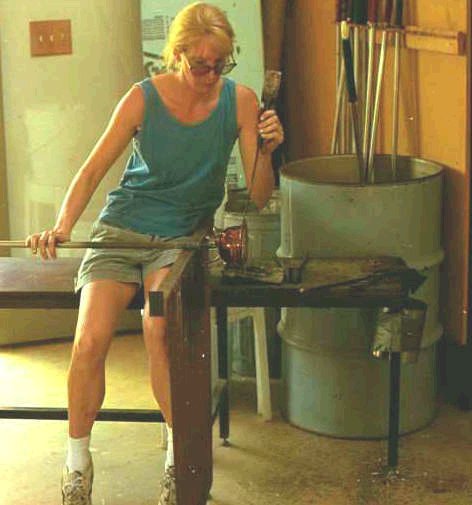 |
| Some of Marti's production work, lined up on shelves near the cold working equipment. Marti hits the legged items with a MAPP torch as soon as they are off the punty to smooth the punty mark to omit some of the cold working.
|
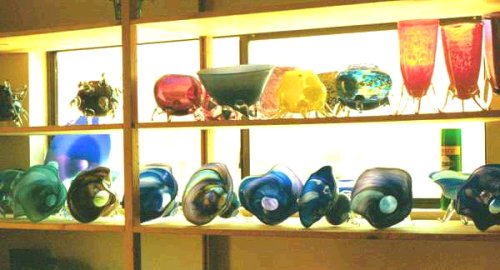 |
| One of the most astonishing collections of blown and cut glass
can be found in an astonishing location: Texas A&M University
in College Station, in the center of the triangle of Dallas, San
Antonio and Houston. The Memorial Student Center (MSC) museums
are there to enhance the college experience of students far from
urban centers, yet the collection of glass offered is unmatched
in any major city in Texas. I have visited several times, the
most recent in April 1998. [Actually, once since then, also. MF] The glass shown here includes turn of the century Tiffany and Steuben as well other 19th century sources of glass. Examples English Cameo glass and American cut crystal of such quality that it travels to exhibits in the U.S.A. and England. The museum brings in traveling shows, including a paperweight show of contemporary and antique weights. 8/24/99
|
|
| Tiffany Glass |
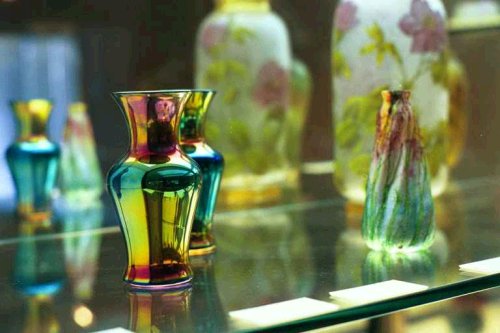 |
| Burmese Glass Fairy Lights |
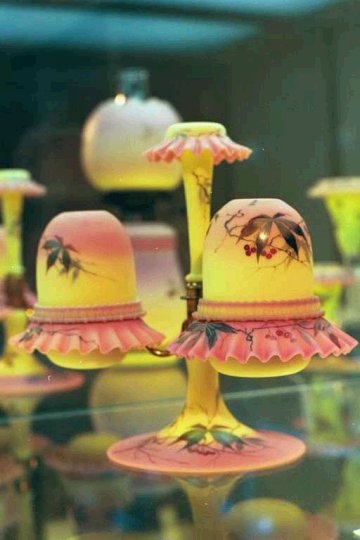 |
| Mixed Case |
 |
Grapevine, Texas, is located just north of the huge D/FW Airport. Grapevine Art Glass is located a block off Main Street which has many shops in historic buildings and a blacksmith in the old train terminal. Betty Hansen runs the gallery that features work by the owners of the studio and other artists from around Texas.
The studio has been reworked twice since my visit. The latest version of info on gallery and studio is on my Texas Glass page.
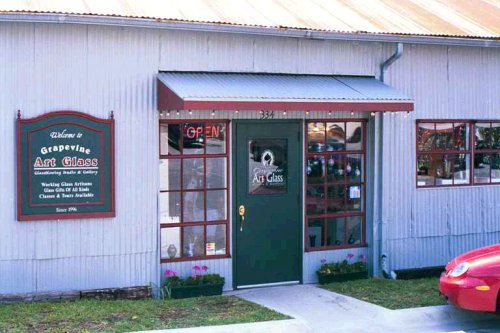
Below, the studio in 1998.
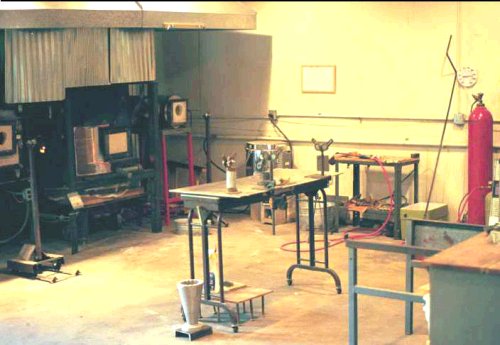
In the Gallery
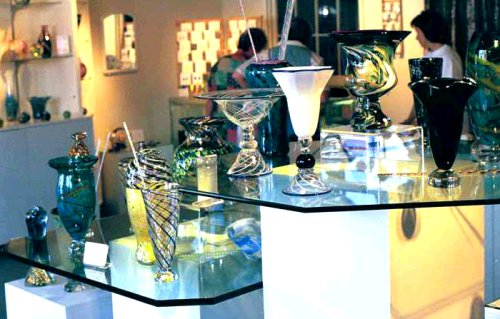
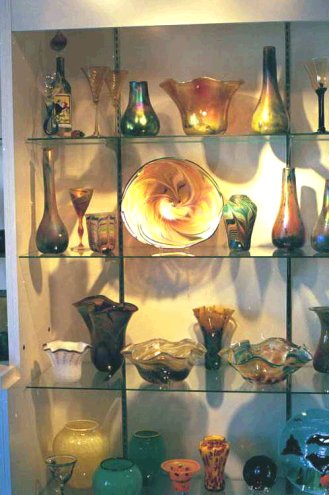
Rev. 2003-05-03 (image size, layout), 2005-02-26
Kittrell/Riffkind Art Glass as a Source
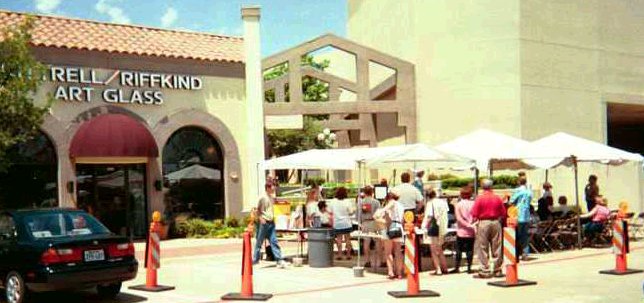 Kittrell-Riffkind Art Glass is located near the intersection
of Beltline and the Dallas North Tollroad in the shopping area
some will recall as Sakowitz Village, just east of the Tollroad.
The gallery portion of the store, under Barbara Kittrell's hand
is mostly hot glass, while Michael Riffkind oversees the stained
glass, fusing, and lampworking classes and supply sales. In early
May 1998, a month long show started with a two day glass blowout
held at the edge of the parking lot with most Texas furnace glass
artists taking a time slot and with lampworking artists doing
demos just inside the door. Kittrell-Riffkind Art Glass is located near the intersection
of Beltline and the Dallas North Tollroad in the shopping area
some will recall as Sakowitz Village, just east of the Tollroad.
The gallery portion of the store, under Barbara Kittrell's hand
is mostly hot glass, while Michael Riffkind oversees the stained
glass, fusing, and lampworking classes and supply sales. In early
May 1998, a month long show started with a two day glass blowout
held at the edge of the parking lot with most Texas furnace glass
artists taking a time slot and with lampworking artists doing
demos just inside the door. |
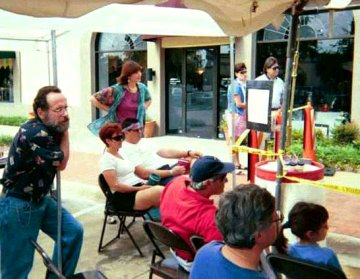 Michael Riffkind (standing), Matthew LaBarbara (seated center),
Diane Flynn (standing center) with the front of KR in the
background, blowing floor to the right. Michael Riffkind (standing), Matthew LaBarbara (seated center),
Diane Flynn (standing center) with the front of KR in the
background, blowing floor to the right. |
| General shot of the blowing floor. The studio was created from
equipment borrowed from various sources, including Art Allison
and Hickory Street Hot Glass. The furnace and glory hole were
fired from propane bottles. The annealer was the regular one in
in K-R, about a 25 yard run from the hot floor. A surprise to me
was the well worn work bench, a standup, but one where the worker
faces the audience. Missed in the photography was Brad Abrams who
has a studio in southeast Dallas.
|
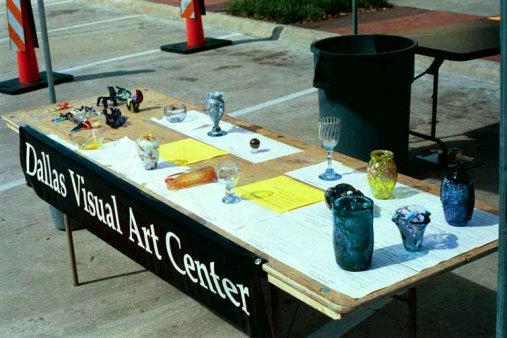 Pieces made at the demos, plus some donated pieces from the
artists were sold at a silent auction to benefit the Dallas
Visual Arts Center, east of downtown. Pieces made at the demos, plus some donated pieces from the
artists were sold at a silent auction to benefit the Dallas
Visual Arts Center, east of downtown. |
 One of the window displays inside Kittrell-Riffkind showing
pieces by some of the artists working glass. One of the window displays inside Kittrell-Riffkind showing
pieces by some of the artists working glass. |
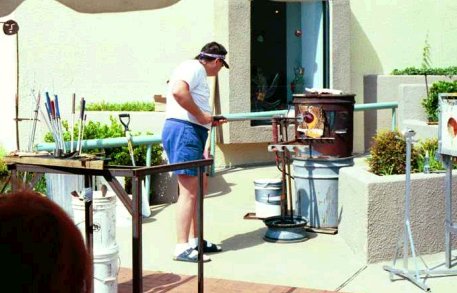 Matthew LaBarbera probably came the
farthest, since his Fire Island studio is in Austin where he
works with his wife, Teresa Ueltschey. Part of their production
are Cave Weights, ovoid multilayered pieces that are ground flat
on one side to cut through the layers and view the cave-like
solid interior. Matthew LaBarbera probably came the
farthest, since his Fire Island studio is in Austin where he
works with his wife, Teresa Ueltschey. Part of their production
are Cave Weights, ovoid multilayered pieces that are ground flat
on one side to cut through the layers and view the cave-like
solid interior. |
 Art Allison works glass beside the road
north from Pottsboro TX to Lake Texoma. Many of his pieces show
distinctive use of dark background glass and metallic fumed
details. Here he is working a quick marble using a modified piece
of tubing held with a pair of pliers. Art Allison works glass beside the road
north from Pottsboro TX to Lake Texoma. Many of his pieces show
distinctive use of dark background glass and metallic fumed
details. Here he is working a quick marble using a modified piece
of tubing held with a pair of pliers. |
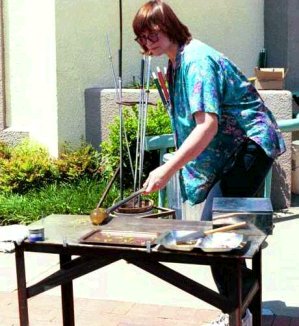 Diane Flynn, besides being very tall, also
is one of the few who works both the lamp and the furnace, having
started with beadmaking and worked up to teaching that before
starting at the furnace. She prepared small leaves and flowers
during her torch demo and used them on the vase she made in her
furnace demo. Here she is just picking them up. Her studio is in
Arlington. Diane Flynn, besides being very tall, also
is one of the few who works both the lamp and the furnace, having
started with beadmaking and worked up to teaching that before
starting at the furnace. She prepared small leaves and flowers
during her torch demo and used them on the vase she made in her
furnace demo. Here she is just picking them up. Her studio is in
Arlington. |
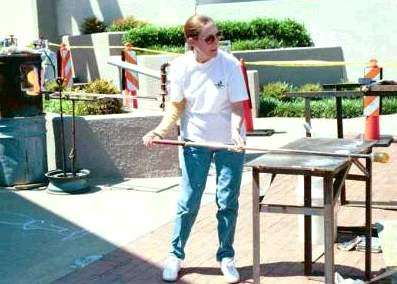 Terry Maxwell owns Divas Glass Art,
Burleson TX, south of Ft. Worth, where she also offers classes.
Terry started with stained glass and does some lampworking as
well as a lot of furnace working. The chalk sketch on the floor
is of a double piece attempted earlier (the piece ended where the
chalk is.) Terry Maxwell owns Divas Glass Art,
Burleson TX, south of Ft. Worth, where she also offers classes.
Terry started with stained glass and does some lampworking as
well as a lot of furnace working. The chalk sketch on the floor
is of a double piece attempted earlier (the piece ended where the
chalk is.) |
Art Allison, Pottsboro TX
Closed 2008
| Art Allison returned to Texas after training and working in glass in
Ohio and Wyoming to build on property owned by his family at a spot exactly
5 miles north of the intersection where the road goes north to Lake Texoma,
total of 90 miles north from my home east of downtown Dallas. Pottsboro is
west of Denison. He built everything himself, setting up for under $5,000 completely equipped. He says one thing he would change is the dirt floor, which gets muddy when rain blows in. Art runs his furnace off of high pressure propane from the large tank behind the building using a venturi burner so when electricity fails he does not lose the glass or the pot. Since these pictures were taken, Art has converted a building 200 feet left of this one into a gallery. Both buildings face the highway a few yards from the shoulder. (more) |
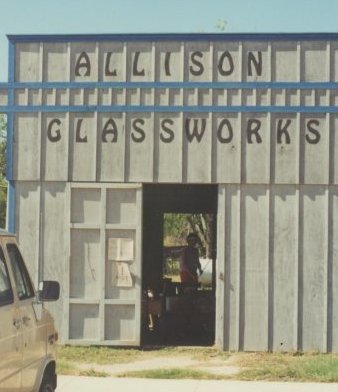 |
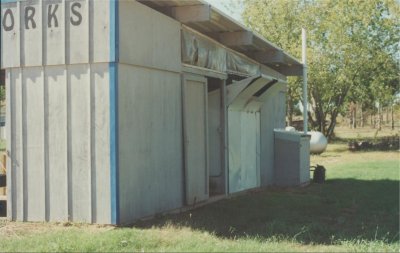 |
|
| Art blows alone on a regular schedule. There is seating for 4-6 people behind the camera position below. The annealers are behind him to the left and are modest in size and heated with clothes dryer elements. The barrel shown in both these pictures is for fuming, which Art did a lot of at this time. A vent leads away in back and both liquid and dry chemicals can be applied. To the right are the old furnace which was rebuilt not long after this was taken and just in the corner of the picture is the glory hole. |
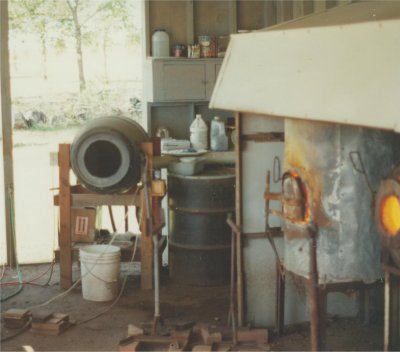 |
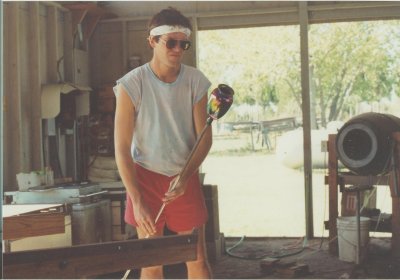 |
| Fire Island Hot Glass Studio, located in a small industrial park on the east side of Austin, Texas, is the oldest glassblowing studio in the state. At the entry to the building leads to an office space with gallery shelves and a small photography stand. A hallway down the left side of the building leads past shelf storage, a shipping counter and cold working space. Beyond these is the blowing floor. The view directly ahead is below. The bench is to the right and the annealers and pipes on the right rear corner as in the photo below. The furnace is the rectangular box with the sloping doors. Matthew LaBarbera and his wife, Teresa Ueltschey, use enough colors that they melts them in several smaller crucibles around a larger clear. The two doors open on one large space that has lots of insulation. floor plan |
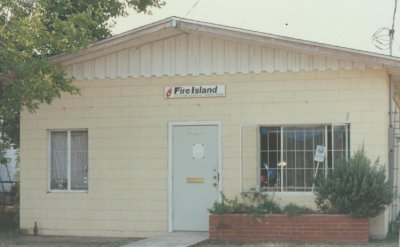 |
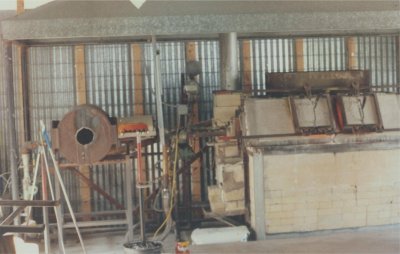 |
In this picture is the pipe cooler which uses a
recirculating pump so it can be positioned without having a hose and a
drain. The unit is mounted on the end of a marver which can be rolled
around the shop. A foot pedal switch turns on the water which cascades
 into
the lower part of the pipe and drains back to the bucket holding the pipe. into
the lower part of the pipe and drains back to the bucket holding the pipe.Also shown is a bracket with threading rollers clamped to the marver with large Vice Grip clamp pliers more commonly used for welding. |
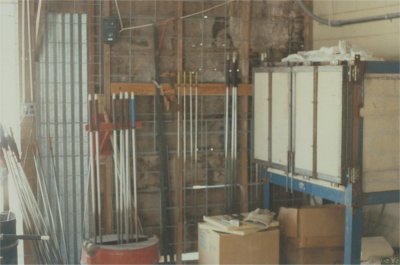 |
|
| In the images below, a wooden turn mold is used to quickly form the basic shape of a bottle or vase. From left to right, the prepared very hot moile is positioned in the mold by the glassblower who is standing on a plastic milk carton being used as a step. The assistant closes the mold, which is made of fruit wood soaked to a waterlogged state, and the blower inflates the moile inside the mold while turning it. On a command from the blower, usually a foot tap, the mold is opened and the piece removed, the blower stepping down and the assistant returning the mold to the bucket to soak.2008-08-15 | |
 |
|